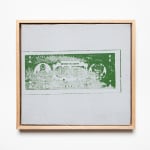
Andy Warhol 1928-1987
One Dollar Bill (Back), 1962
Silkscreen ink on linen
24 x 26 cm; (9 1/2 x 10 1/4 in.)
Copyright The Artist
